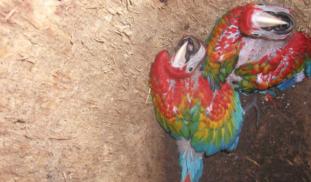Please wait...
About This Project
Wild Scarlet Macaw populations are declining due to the illegal trade and habitat loss. Although Scarlet Macaws lay 2-4 eggs, macaw parents will only feed the 1st and 2nd chick, while the others starve to death. We will develop techniques to increase survival of these chicks by moving them into new nests with no chicks, or only 1 chick. Our research suggests that the new parents will adopt and care for their new chicks, allowing them to reach maturity and fledge from the nest.
More Lab Notes From This Project

Browse Other Projects on Experiment
Related Projects
How do polar bears stay healthy on the world's worst diet?
Polar bears survive almost entirely on seal fat. Yet unlike humans who eat high-fat diets, polar bears never...
Uncovering hidden insect diversity associated with a likely undescribed gall-forming midge
Does a likely undescribed species of gall-forming midge (pers. comm. Ray Gagné) on Eriodictyon plants (Yerba...
Macrofungi of the California archipelago
The eight islands of the California Archipelago are a well-studied biodiversity hotspot — but we know almost...




